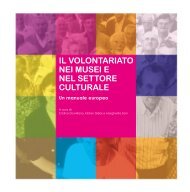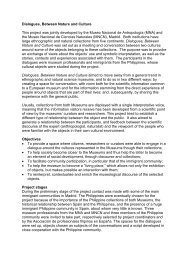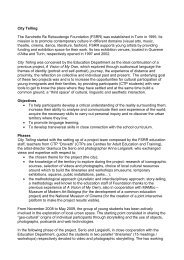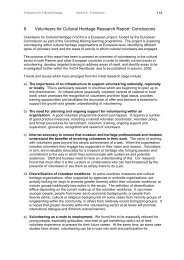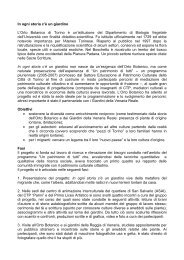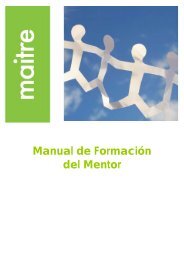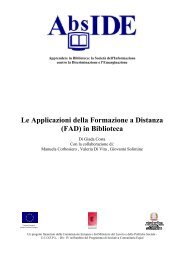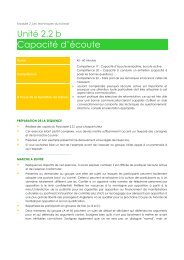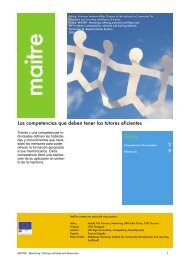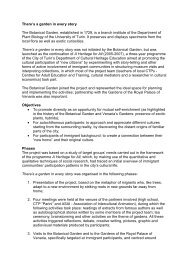Museums as places for intercultural dialogue - Network of European ...
Museums as places for intercultural dialogue - Network of European ...
Museums as places for intercultural dialogue - Network of European ...
Create successful ePaper yourself
Turn your PDF publications into a flip-book with our unique Google optimized e-Paper software.
The ability <strong>of</strong> the museum to trigger reflections, to suggest alternativeways <strong>of</strong> looking at the cultural heritage it preserves evokes what HomiBhaha calls ‘the Third Space <strong>of</strong> enunciations’: ‘the “inter” – the cuttingedge <strong>of</strong> translation and negotiation, the in between space – that carriesthe burden <strong>of</strong> the meaning <strong>of</strong> culture... By exploring this Third Space,we may elude the politics <strong>of</strong> polarity and emerge <strong>as</strong> the others <strong>of</strong>ourselves.’ 5 In so doing we recognise the relativity <strong>of</strong> truths in order tohave “multiple versions” rather than “objective truths,” and do the samewith identities, which are manifold rather than defined once and <strong>for</strong> all.<strong>Museums</strong> <strong>as</strong> Spaces <strong>of</strong> NegotiationElena Delgado<strong>Museums</strong>, like other cultural institutions, should strive not only to becapable <strong>of</strong> representing otherness, but also to acknowledge the limits<strong>of</strong> interpretation and translation; they should not <strong>as</strong>sume that the studyand documentation <strong>of</strong> collections are enough to make the object‘transparent.’ 6 We cannot pretend, not even <strong>as</strong> scholars or specialists,to know all the codes underlying any object.In playing their role <strong>as</strong> interpreter-mediators, museums can recognisecultural difference through a range <strong>of</strong> activities (including workshops,conferences, concerts and events), by sharing imageries, by promotingthe ‘rhizomic identity’ 7 mentioned by Eduard Glissant, respecting the‘opacity’ <strong>of</strong> the other <strong>as</strong> well <strong>as</strong> <strong>of</strong> his / her <strong>for</strong>ms <strong>of</strong> expression, andacknowledging that cultural cross-fertilisation is inherent in all societies.<strong>Museums</strong> have long been considered emblematic spaces <strong>for</strong>consolidating the values and identity <strong>of</strong> the society by which they werecreated, 1 transmitting monologues which, until recently, could not bequestioned.In today’s complex world, where cultural references can becomeblurred between virtuality and nomadism, museums must be capable<strong>of</strong> repositioning themselves and show a willingness to questionthe objectivity <strong>of</strong> the dominant cultural context, making way <strong>for</strong> thereferences and perspectives <strong>of</strong> new social actors.The significance <strong>of</strong> a museum lies not only in its collections, but alsoin the reflections and insights it is able to trigger around the objects,the knowledge it provides and the multiple visions and interpretationsit <strong>of</strong>fers on the heritage in its care. It is necessary to acknowledgethat the original meaning <strong>of</strong> an object is lost the moment it entersthe museum’s walls. The ability <strong>of</strong> a museum to unfold narrativesand suggest inferences allows it to act <strong>as</strong> a plat<strong>for</strong>m <strong>for</strong> reflection onknowledge systems, beliefs, values and attitudes. The museum site,its architecture, exhibition spaces and the surrounding urban or naturalenvironment are resources to be exploited with a view to developingnew strategies <strong>for</strong> social <strong>dialogue</strong>.<strong>Museums</strong> must respond to new patterns <strong>of</strong> knowledge production andtransmission, <strong>as</strong> well <strong>as</strong> to the new social configurations within localcontexts, where tensions and frictions produced within and acrossnational borders may be evident.As metaphorical “free zones”, museums must strive to ‘take their placeat the intersections, in those spaces where individuals and distinctcultural identities can act and interact, trans<strong>for</strong>m and be trans<strong>for</strong>med.’ 2By taking on this new function, museums can become neutral spaceswhere differences and mutual difficulties <strong>of</strong> understanding, habituallyexperienced <strong>as</strong> limits and sources <strong>of</strong> conflict, become somethingvaluable: ‘new opportunities <strong>for</strong> active citizenship.’ 3The <strong>European</strong> project MAP <strong>for</strong> ID recognises and promotes the socialdimension <strong>of</strong> the museum and its ability to bolster mutual knowledge,and there<strong>for</strong>e the ability <strong>of</strong> people to live together. To think <strong>of</strong> museums<strong>as</strong> <strong>places</strong> <strong>of</strong> <strong>intercultural</strong> <strong>dialogue</strong> requires us to question the socialsegmentation resulting from multicultural policies, in which therecognition <strong>of</strong> cultural diversity and distinct identities <strong>of</strong>ten ends uprein<strong>for</strong>cing discrimination and segregation.According to Néstor García Canclini, ‘the concept <strong>of</strong> <strong>intercultural</strong>ityreminds us <strong>of</strong> interaction and encounter, i.e. what happens when arelationship <strong>of</strong> exchange is established between groups. Where<strong>as</strong>multiculturality entails the acceptance <strong>of</strong> difference, <strong>intercultural</strong>ityimplies that negotiation, conflict and mutual exchange exist betweendifferent groups.’ 4In order to become a space <strong>for</strong> negotiation, museums must disownthose homogenising and discriminating values which are still veryclosely connected to their role in legitimising historic identity. Only thenwill people <strong>of</strong> different origin, background and attitude have accessto the knowledge embodied in objects and artefacts, to their p<strong>as</strong>t,present and future narratives, and, eventually, to a collective meaningmakingprocess.As Martin Barbero points out, one t<strong>as</strong>k <strong>for</strong> cultural and educationalinstitutions should be the development <strong>of</strong> strategies to help citizenslearn to live with conflict, with the other and with difference, bypromoting attitudes which lead to the intersection <strong>of</strong> cultures and <strong>of</strong>knowledge. 8<strong>Museums</strong> must reflect on new strategies <strong>for</strong> meaning-making, <strong>as</strong> well<strong>as</strong> on museological solutions best suited to safeguarding democraticrights in the framework <strong>of</strong> contemporary social and cultural tensionsproduced by globalisation, by staking on what Seyla Benhabib defines<strong>as</strong> the t<strong>as</strong>k <strong>of</strong> democratic equality: ‘to create impartial institutions in thepublic sphere and civil society where the struggle <strong>for</strong> the recognition<strong>of</strong> cultural differences and contestation <strong>for</strong> cultural narratives can takeplace without domination.’ 91C. Duncan, Civilising rituals inside public art museums, Routledge, London and NewYork, 1995.2N. García Canclini, Diferentes, desiguales y desconectados. Map<strong>as</strong> de la <strong>intercultural</strong>idad,Barcelona, Gedisa, 2006, p. 166.3Ibid., p. 166.4Ibid., p. 15.5H. Bhabha, The location <strong>of</strong> culture, Routledge, London and New York, 1994, p. 56.6E. Glissant, Introduction à une poétique du divers, Gallimard, Paris, 1996. ‘I don’t needto “understand” the other, in the sense <strong>of</strong> simplifying him or her on the b<strong>as</strong>is <strong>of</strong> my ownexperience, in order to live with this other or to create something with him or her. Todaythe right to opacity should consist in the <strong>as</strong>sertion <strong>of</strong> the concept <strong>of</strong> non-barbarity.’7Ibid..8J. Martin-Barbero, Oficio de cartógrafo, Fondo Cultura Económica, Santiago de Chile,2002.9S. Benhabib, The Claims <strong>of</strong> Culture. Equality and Diversity in the Global Era, PrincetonUniversity Press, Princeton and Ox<strong>for</strong>d, 2002.8 9



